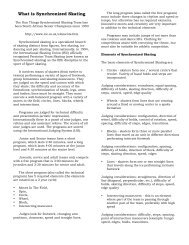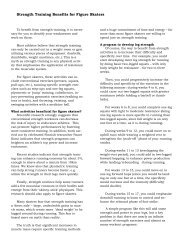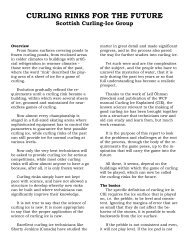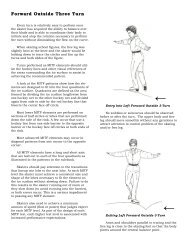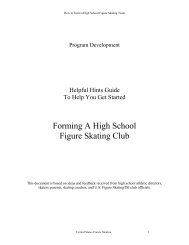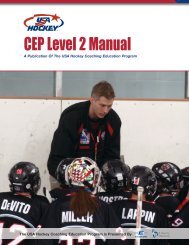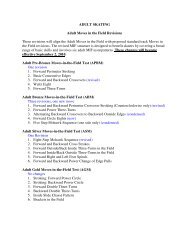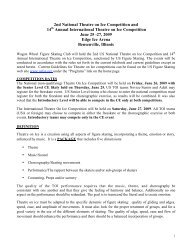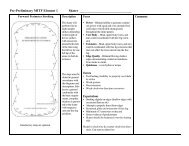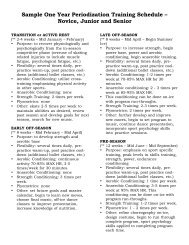CEP Level 3 Manual - Rushmore Hockey Association
CEP Level 3 Manual - Rushmore Hockey Association
CEP Level 3 Manual - Rushmore Hockey Association
You also want an ePaper? Increase the reach of your titles
YUMPU automatically turns print PDFs into web optimized ePapers that Google loves.
T A B L E O F C O N T E N T SDOUBLE BACK PASSA. This option requires agreement by theforward line that on a specific rush (firsttime, or every time this shift, etc.) they willplay for a double back pass.B. Same as Option 1 (back pass) except W2moves across the ice and accepts the secondback pass from C, and W1 curls behind thenet to look for a pass from W2 or a rebound.Developing a team offense can provide greatsatisfaction for you and your players. Be sure thatyou and your players remember that as long as yougive each pattern a best effort, you should not bedisturbed by lack of success. If one in 10 worksvery well, that’s good. As players become moreskillful, two or three in 10 may be a good level ofsuccess.NOTES: Offense in the Offensive Zone• Always place one forward in the high slot.This results in maintaining a good offensiveposition and a good defensive position forbackchecking• Two forwards attack the net• The roles of the defensemen areconservative, allowing them the freedom tomove into the high slotPOWER PLAY SITUATIONSThere are many different types of power playswhich may be utilized. In order for the coach tomake a decision regarding the type of power playyou wish to use, answer the following questions.1. What is the size of the rink, the size of thecorners, and the distance behind the goalline (10 feet or 15 feet)?2. What is the general condition of the ice?3. What players will you use?• The next unit?• The next line up?• A mixed line utilizing particularplayers?• Forward(s) playing defense orregular defensemen?• Players on the off-wing?• Specific power play unit?4. Do you want a particular player leading therush up the ice?5. Do you want to utilize quick rushes and playfor the quick shot?6. Do you want to set up designed plays?7. What are the responsibilities of each player?8. Who is the quarterback?9. What type of defense is the opposing teamutilizing?You must also consider what you want yourplayers to do in each of the three zones while on thepower play. Some of the options include:1. Defensive Zone• Fast breakout• Semi-controlled breakout• Controlled breakout2. Neutral Zone• Carrying the puck into offensivezone• Passing the puck into offensive zone• Shooting the puck into offensivezone• Various “pick” plays3. Offensive Zone• Designed play• Quick shot/reboundSome of the skills that make a player effective inpower play situations include:1. Passing skills2. One-touch passing skills3. Shooting off the pass4. Ability to read defenses5. One-on-one puck control skillsGUIDELINES FOR EXECUTINGEFFECTIVE POWER PLAYS1. Maintain possession of the puck2. Keep the puck moving3. Penetrate the offensive zone4. Passes to where teammates will be — not towhere they are or have been2-1-2 POWER PLAYThe 2-1-2 Power Play is a basic play thatprovides a balanced attack and multiple options.Either a forward or defenseman may quarterback ordirect this play. It may originate deep in theoffensive zone, outside at the blue line, or from theboards. The primary objective is to maneuver thepuck to the man in the slot. Figures 15 through 19illustrate options of the 2-1-2 Power Play.LDLWFigure 15. Basic alignment for the 2-1-2power play.Two forwards (LW and RW) are deep in thezone, one forward is in the slot. The defensemenplay normal positions on the blue line.LDLWCFigure 16. The 2-1-2 with play shifted to theboards.CRWRDRWRDLWFigure 17. Forward movement in the 2-1-2power play.The three forwards have room to move withoutaltering the 2-1-2 alignment. The deep forwardshave more freedom to move and redirect the playthan does the forward in the slot.LWLDFigure 18. Defensemen movement in the2-1-2 power play.CThe defensemen (LD and RD) can move alongthe blue line. The forwards should adjust to theirmovement with a corresponding move in the samedirection. The LD and RD can pass betweenthemselves. The two deep forwards (LW and RW)should be taught to skate around to createopenings.CRDRWRW182 | USA <strong>Hockey</strong> Coaching Education Program <strong>Level</strong> 3 <strong>Manual</strong>Offensive Team Tactics | 183



